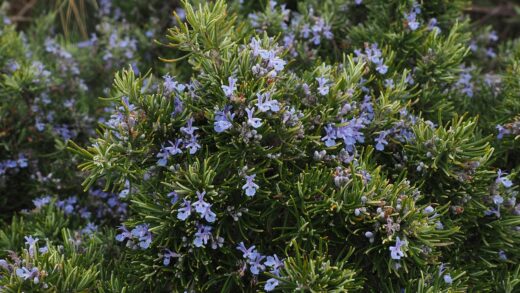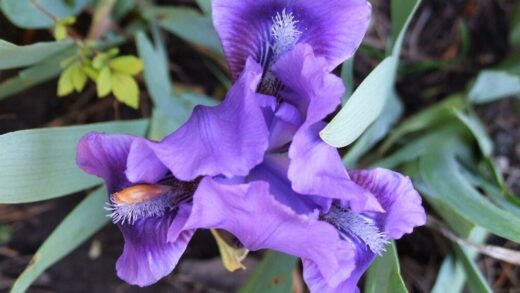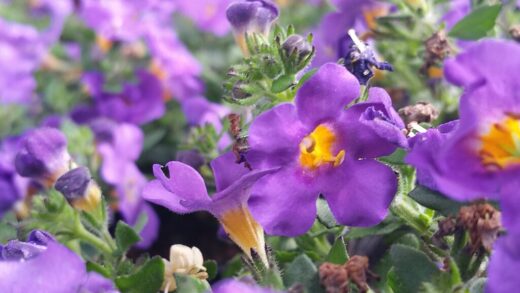Understanding lavender’s preference for lean soil
To cultivate vibrant and fragrant English lavender, it is essential to first understand that its nutritional needs are fundamentally different from many other garden perennials. This plant has its origins in the rocky, alkaline, and nutrient-poor soils of the Mediterranean region. As a result, it has evolved to be highly efficient at extracting the nutrients it needs from its environment and does not require, nor does it appreciate, rich, fertile soil. This preference for “lean” conditions is a cornerstone of proper lavender care, and attempting to coddle it with excessive fertilizer or rich compost is one of the most common paths to failure. Providing too many nutrients can lead to a host of problems that ultimately undermine the health and beauty of the plant.
The primary issue with over-fertilizing lavender, particularly with nitrogen-rich formulas, is that it stimulates vigorous, lush foliage growth at the direct expense of flower production. While the plant may appear large and green, it will produce fewer flower spikes, and the blooms it does create will be less fragrant. This is because the plant diverts its energy into producing leaves rather than the essential oils that are responsible for both the iconic scent and the intensity of the blooms. In essence, by feeding it too much, you are encouraging it to behave more like a leafy green and less like the prolific flowering herb it is meant to be.
Furthermore, the soft, fleshy growth prompted by excess nitrogen is far more susceptible to a range of problems. This tender foliage is a prime target for pests like aphids and is much more vulnerable to fungal diseases, such as botrytis, especially in damp or humid conditions. Additionally, this rapid, late-season growth does not have sufficient time to harden off before the arrival of winter, making the plant significantly more susceptible to damage from frost and cold temperatures. A lavender plant grown in lean soil, by contrast, will have tougher, more resilient growth that is better equipped to withstand environmental stresses.
Therefore, the goal when considering the nutritional needs of lavender is not to “feed” it in the traditional sense but to ensure the soil provides the basic mineral building blocks in a modest, balanced way. The focus should be on creating the right soil structure—gritty and well-draining—rather than on enriching it with large amounts of organic matter or synthetic fertilizers. By replicating the sparse conditions of its native habitat, you encourage the plant to develop a strong root system and produce the highly concentrated oils that make it so beloved, resulting in a healthier, more aromatic, and longer-lived specimen.
Fertilizing at the time of planting
While mature English lavender plants rarely need supplemental feeding, providing a small nutritional boost at the time of planting can be beneficial, helping the young plant to establish a strong root system more quickly. This initial fertilization is not about creating rich soil but about ensuring that the essential nutrients for root development are available as the plant transitions into its new environment. The key is to use a gentle, slow-release source of nutrients that will not overwhelm the young plant or burn its delicate, developing roots.
An excellent option for this initial feeding is to incorporate a small amount of bone meal or a balanced, organic granular fertilizer into the backfill soil. Bone meal is particularly beneficial as it is a fantastic natural source of phosphorus, a crucial nutrient that plays a vital role in promoting robust root growth. A tablespoon or two mixed thoroughly into the soil at the bottom of the planting hole is typically sufficient. This provides a targeted nutrient source directly to the root zone where it is needed most during the establishment phase.
Alternatively, amending the planting area with a small quantity of high-quality, well-rotted compost can also provide a gentle, slow-release form of nutrition. It is important to use compost sparingly, viewing it more as a soil conditioner than a potent fertilizer. A shovelful mixed into the soil of a large planting hole will not only provide a balanced range of micronutrients but will also help to improve the soil’s structure and drainage. This approach creates a healthy soil ecosystem that supports the plant’s growth in a natural and sustainable way.
It is critical to avoid using high-nitrogen, fast-acting synthetic fertilizers when planting lavender. These can easily scorch the roots of a young plant and will encourage weak, spindly top growth before the root system has had a chance to become properly established. This creates an imbalanced plant that is more susceptible to stress, wind damage, and disease. The focus at planting time should always be on building a healthy foundation below the ground, and a gentle, phosphorus-rich amendment is the best way to achieve this goal.
Ongoing fertilization for mature plants
For mature, established English lavender plants growing in the ground, the need for ongoing fertilization is minimal to non-existent in most garden soils. As long as the plant is healthy, growing steadily, and producing a good show of flowers each year, you can assume that it is finding all the nutrients it requires from the surrounding soil. Adding fertilizer to a plant that is already performing well is unnecessary and, as previously discussed, can often do more harm than good, leading to weak growth and fewer, less fragrant flowers.
If your soil is exceptionally poor and sandy, or if you notice that your lavender’s growth seems stunted and its flower production has declined over several years, a very light feeding in the early spring may be warranted. This should be done just as new growth begins to appear at the base of the plant. A light top-dressing with a handful of well-rotted compost or a very small application of a balanced, slow-release organic fertilizer is all that is needed. Gently scratch it into the soil surface around the plant’s drip line, being careful not to disturb the roots.
The timing of any supplemental feeding is crucial. All fertilization should cease by mid-summer at the latest. Applying fertilizer in the late summer or autumn can stimulate a flush of new, tender growth that will not have adequate time to mature and harden off before the first frosts. This vulnerable new growth is highly susceptible to winter kill, which can damage the plant’s structure and create entry points for diseases. Allowing the plant to slow its growth naturally in the latter half of the season is essential for its preparation for winter dormancy.
In many cases, the best way to provide long-term nutrition for lavender is not through direct fertilization but by nurturing the health of the soil itself. Applying a thin layer of organic mulch, such as pea gravel, can help to conserve soil moisture and suppress weeds. As organic mulches like compost break down, they slowly release nutrients into the soil. However, with lavender, an inorganic mulch like gravel is often preferred as it keeps the crown of the plant dry and reflects heat, which lavender enjoys.
Special considerations for container-grown lavender
The nutritional needs of English lavender grown in containers are fundamentally different from those of plants grown in the garden. The limited volume of soil in a pot can become depleted of its essential nutrients over time due to the regular watering that leaches them out through the drainage holes. Therefore, container-grown lavender requires a more proactive, albeit still restrained, approach to fertilization to ensure it has the nutrients it needs to thrive throughout the growing season.
A good strategy for potted lavender is to feed it with a diluted liquid fertilizer every four to six weeks during the spring and summer months when the plant is in its active growth phase. Choose a fertilizer that is formulated for flowering plants, and look for one that is low in nitrogen and higher in phosphorus and potassium to encourage blooming rather than excessive foliage. It is highly recommended to dilute the fertilizer to half the strength suggested on the packaging to avoid over-feeding and the potential for root burn.
The choice of potting medium is also a key factor in managing the nutrition of container-grown lavender. A high-quality, well-draining potting mix that contains a slow-release fertilizer can provide a steady, gentle supply of nutrients for the first few months. When repotting your lavender, which should be done every couple of years, refreshing the soil provides a complete reset of the available nutrients. This is often the best time to incorporate a granular, slow-release fertilizer into the new potting mix.
As with garden-grown plants, it is vital to cease all feeding of containerized lavender by the end of summer. This signals to the plant that it is time to slow down its growth and begin preparing for winter dormancy. Continuing to fertilize into the autumn will encourage weak, leggy growth that is ill-prepared for the colder temperatures. By aIlowing the plant to follow its natural seasonal cycle, you ensure it remains healthy and resilient, ready to burst forth with new growth the following spring.




















